A Knowledge Graph-Driven CNN for Radar Emitter Identification
Abstract
1. Introduction
- A knowledge graph model of a radar emitter is proposed and measures the relationship between radar data in the model.
- A mechanism is proposed to construct the precise dataset based on the radar emitter knowledge graph.
- A new method of specific emitter identification is proposed based on the 1D-CNN to identify the emitter on the precise intermediate frequency (IF) radar dataset.
2. Related Work
2.1. Specific Emitter Identification
2.2. LFM Radar Signal
2.3. Characteristic Analysis of Radar Signal
2.3.1. Envelope Features
2.3.2. Phase Noise Characteristics
2.4. Knowledge Graph
3. Methods
- At first, we construct the knowledge graph of the radar emitter. The knowledge graph is used to provide a qualitative and quantitative representation of the relationship between radar data while in the process of radar emitter identification.
- Secondly, a precise dataset of specific tasks is compiled. For the specific recognition tasks, we performed data selection and identification difficulty ranking based on the constructed knowledge graph to construct the precise dataset.
- Thirdly, we constructed a radar emitter identification network based on the knowledge graph. On the basis of the selected training data (precise dataset), the network is adjusted so that it can identify targets from simple to complex based on prior knowledge.
3.1. Construct Radar Emitter Knowledge Graph
- Node: In graph structures, a node is a vertex in a graph. The knowledge graph expands on the graph’s basis, and a node is a vertex composed of entities and concepts.
- Edge: In a graph, an edge is a line between nodes. In the knowledge graph, edges represent the connections between nodes, comprising relationships and attributes.
- Radar emitter individual: the radar emitter individual is a unique radar with fingerprint characteristics, and all emitters mentioned in this paper refer to the radar emitter.
- Step 1: Node Modeling: this section primarily implements the mapping of radar data to the nodes in the knowledge graph.
- Step 2: Edge Modeling: the relationship between radar data is materialized as the edges between nodes, and the proposed measure model is used for qualitative and quantitative measurements.
- Step 3: Radar Emitter Knowledge Graph Construction: by integrating the results of step 1 and step 2, a radar emitter knowledge graph is formed to represent the interaction between radar data during the radar identification process.
3.1.1. Node
| Algorithm 1: The Nodes Construction Algorithm |
3.1.2. Edge
| Algorithm 2: The Edges Quantification Algorithm |
3.1.3. Radar Emitter Knowledge Graph
| Algorithm 3: Knowledge Graph of Radar Emitter Structuring Algorithm |
3.2. Precise Dataset Construction
3.3. The Proposed Specific Emitter Identification Method
3.3.1. Specific Emitter Identification via 1D-CNN
3.3.2. Specific Emitter Identification via Knowledge Graph and 1D-CNN
3.4. Computational Complexity Analysis
4. Experiments
4.1. Experiment Settings
4.2. Construction Experiment of Radar Emitter Knowledge Graph
4.3. Results
- First, as in Section 3.2, we extract the task-related subgraph according to the task scene, and the specific formula for extraction is as follows:
- Second, the task subgraph is ranked from easy to difficult to construct the corresponding precise dataset for the target.
- Third, the precise dataset is divided into a training set and a test set. In all the subsequent experiments, the number ratio of the training data to test the data is 8:2, and 1/8 of the training data is used as the validation data. As in Algorithm 4, the training set is fed into the network for training to obtain a well-trained recognition model. Finally, the test set is fed into the recognition model to obtain the recognition accuracy.
Algorithm 4: Specific Emitter Identification via KG and 1D-CNN Algorithm
4.3.1. Experiments on Five Test Problems
4.3.2. Comparisons with Other Methods
5. Conclusions
Author Contributions
Funding
Data Availability Statement
Acknowledgments
Conflicts of Interest
References
- Zohuri, B. Electronic countermeasure and electronic counter-countermeasure. In Radar Energy Warfare and the Challenges of Stealth Technology; Springer: Berlin/Heidelberg, Germany, 2020; pp. 111–145. [Google Scholar]
- Cao, R.; Cao, J.; Mei, J.-p.; Yin, C.; Huang, X. Radar emitter identification with bispectrum and hierarchical extreme learning machine. Multimed. Tools Appl. 2019, 78, 28953–28970. [Google Scholar] [CrossRef]
- Ting, C.; Wei, G.; Bing, S. A new radar emitter recognition method based on pulse sample figure. In Proceedings of the 2011 Eighth International Conference on Fuzzy Systems and Knowledge Discovery (FSKD), Shanghai, China, 26–28 July 2011; pp. 1902–1905. [Google Scholar]
- Jin, Q.; Wang, H.; Yang, K. Radar emitter identification based on EPSD-DFN. In Proceedings of the 2018 IEEE 3rd Advanced Information Technology, Electronic and Automation Control Conference (IAEAC), Chongqing, China, 12–14 October 2018; pp. 360–363. [Google Scholar]
- Matuszewski, J.; Sikorska-Łukasiewicz, K. Neural network application for emitter identification. In Proceedings of the 2017 18th International Radar Symposium (IRS), Prague, Czech Republic, 28–30 June 2017; pp. 1–8. [Google Scholar]
- Dash, D.; Valarmathi, J. Radar Emitter Identification in Multistatic Radar System: A Review. In Proceedings of the International Conference on Automation, Signal Processing, Instrumentation and Control, Singapore, 27–28 February 2021; pp. 2655–2664. [Google Scholar]
- Kong, M.; Zhang, J.; Liu, W.; Zhang, G. Radar emitter identification based on deep convolutional neural network. In Proceedings of the 2018 International Conference on Control, Automation and Information Sciences (ICCAIS), Hangzhou, China, 24–27 October 2018; pp. 309–314. [Google Scholar]
- Wang, J.; Wang, X.; Tian, Y.; Chen, Z.; Chen, Y. A Radar Emitter Recognition Mechanism Based on IFS-Tri-Training Classification Processing. Electronics 2022, 11, 1078. [Google Scholar] [CrossRef]
- Shi, Y.; Zhang, W.; Zhu, M.; Wang, L.; Xu, S. Specific Radar Emitter Identification: A Comprehensive Review. J. Electron. Inf. Technol. 2022, 44, 1–14. [Google Scholar]
- Zhu, M.; Feng, Z.; Zhou, X. A Novel Data-Driven Specific Emitter Identification Feature Based on Machine Cognition. Electronics 2020, 9, 1308. [Google Scholar] [CrossRef]
- Yu, H.-h.; Yan, X.-p.; Liu, S.-k.; Li, P.; Hao, X.-h. Radar emitter multi-label recognition based on residual network. Def. Technol. 2021, 18, 410–417. [Google Scholar]
- Yao, Y.; Yu, L.; Chen, Y. Specific emitter identification based on square integral bispectrum features. In Proceedings of the 2020 IEEE 20th International Conference on Communication Technology (ICCT), Nanning, China, 28–31 October 2020; pp. 1311–1314. [Google Scholar]
- Pan, Y.; Yang, S.; Peng, H.; Li, T.; Wang, W. Specific emitter identification based on deep residual networks. IEEE Access 2019, 7, 54425–54434. [Google Scholar] [CrossRef]
- Xiao, Y.; Wei, X. Specific emitter identification of radar based on one dimensional convolution neural network. J. Phys. Conf. Ser. 2020, 1550, 032114. [Google Scholar] [CrossRef]
- Hinton, G.E.; Osindero, S.; Teh, Y.-W. A fast learning algorithm for deep belief nets. Neural Comput. 2006, 18, 1527–1554. [Google Scholar] [CrossRef]
- Bengio, Y.; Lamblin, P.; Popovici, D.; Larochelle, H. Greedy layer-wise training of deep networks. In Proceedings of the Twentieth Annual Conference on Neural Information Processing Systems, Vancouver, BC, Canada, 4–7 December 2006; Volume 19. [Google Scholar]
- Ranzato, M.A.; Poultney, C.; Chopra, S.; Cun, Y. Efficient learning of sparse representations with an energy-based model. In Advances in Neural Information Processing Systems; MIT Press: Cambridge, MA, USA, 2006; Volume 19. [Google Scholar]
- Singhal, Amit.: Introducing the Knowledge Graph: Things, Not Strings. Google Blog 16, May, 2012. Available online: https://blog.google/products/search/introducing-knowledge-graph-things-not (accessed on 31 May 2023).
- Pham, T.; Tao, X.; Zhang, J.; Yong, J.; Li, Y.; Xie, H. Graph-based multi-label disease prediction model learning from medical data and domain knowledge. Knowl. Based Syst. 2022, 235, 107662. [Google Scholar] [CrossRef]
- Li, F.-L.; Chen, H.; Xu, G.; Qiu, T.; Ji, F.; Zhang, J.; Chen, H. AliMeKG: Domain knowledge graph construction and application in e-commerce. In Proceedings of the 29th ACM International Conference on Information & Knowledge Management, Virtual, 19–23 October 2020; pp. 2581–2588. [Google Scholar]
- Cheng, D.; Yang, F.; Wang, X.; Zhang, Y.; Zhang, L. Knowledge graph-based event embedding framework for financial quantitative investments. In Proceedings of the 43rd International ACM SIGIR Conference on Research and Development in Information Retrieval, Virtual, 25–30 July 2020; pp. 2221–2230. [Google Scholar]
- Chen, Y.; Kuang, J.; Cheng, D.; Zheng, J.; Gao, M.; Zhou, A. AgriKG: An agricultural knowledge graph and its applications. In Proceedings of the International Conference on Database Systems for Advanced Applications, Chiang Mai, Thailand, 22–25 April 2019; pp. 533–537. [Google Scholar]
- Haussmann, S.; Seneviratne, O.; Chen, Y.; Ne’eman, Y.; Codella, J.; Chen, C.-H.; McGuinness, D.L.; Zaki, M.J. FoodKG: A semantics-driven knowledge graph for food recommendation. In Proceedings of the International Semantic Web Conference, Auckland, New Zealand, 26–30 October 2019; pp. 146–162. [Google Scholar]
- Li, L.; Ji, H.-B.; Jiang, L. Quadratic time–frequency analysis and sequential recognition for specific emitter identification. IET Signal Process. 2011, 5, 568–574. [Google Scholar] [CrossRef]
- Yang, L.; Zhang, S.; Xiao, B. Radar emitter signal recognition based on time-frequency analysis. In Proceedings of the IET International Radar Conference 2013, Xi’an, China, 14–16 April 2013; pp. 1–4. [Google Scholar]
- Xiao, Z.; Yan, Z. Radar Emitter Identification Based on Novel Time-Frequency Spectrum and Convolutional Neural Network. IEEE Commun. Lett. 2021, 25, 2634–2638. [Google Scholar] [CrossRef]
- Baldini, G.; Gentile, C. Transient-based internet of things emitter identification using convolutional neural networks and optimized general linear chirplet transform. IEEE Commun. Lett. 2020, 24, 1482–1486. [Google Scholar] [CrossRef]
- Man, P.; Ding, C.; Ren, W.; Xu, G. A Specific Emitter Identification Algorithm under Zero Sample Condition Based on Metric Learning. Remote Sens. 2021, 13, 4919. [Google Scholar] [CrossRef]
- Merchant, K.; Revay, S.; Stantchev, G.; Nousain, B. Deep Learning for RF Device Fingerprinting in Cognitive Communication Networks. IEEE J. Sel. Top. Signal Process. 2018, 12, 160–167. [Google Scholar] [CrossRef]
- Jiang, H.; Guan, W.; Ai, L. Specific radar emitter identification based on a digital channelized receiver. In Proceedings of the 2012 5th International Congress on Image and Signal Processing, Agadir, Morocco, 28–30 June 2012; pp. 1855–1860. [Google Scholar]
- Cheng, F.; Ying, N. Visualization and Re-extraction Technology of 2D Radar Envelope Data. Comput. Mod. 2018, 1, 69–73. [Google Scholar] [CrossRef]
- Herzel, F.; Ergintav, A.; Sun, Y. Phase noise modeling for integrated PLLs in FMCW radar. IEEE Trans. Circuits Syst. II Express Briefs 2013, 60, 137–141. [Google Scholar] [CrossRef]
- Eder, J.S. Knowledge Graph Based Search System. US20120158633A1, 24 February 2012. [Google Scholar]
- Chen, Z.; Wang, Y.; Zhao, B.; Cheng, J.; Zhao, X.; Duan, Z. Knowledge graph completion: A review. IEEE Access 2020, 8, 192435–192456. [Google Scholar] [CrossRef]
- Chen, X.; Jia, S.; Xiang, Y. A review: Knowledge reasoning over knowledge graph. Expert Syst. Appl. 2020, 141, 112948. [Google Scholar] [CrossRef]
- Zheng, D.; Long, Y.; Zhou, Z.; Chen, W.; Li, J.; Tang, Y. Scholar-Course Knowledge Graph Construction Based on Graph Database Storage. In Proceedings of the International Symposium on Emerging Technologies for Education, Zhuhai, China, 11 November 2021; pp. 448–459. [Google Scholar]
- Herr, B.W.; Ke, W.; Hardy, E.; Borner, K. Movies and actors: Mapping the internet movie database. In Proceedings of the 2007 11th International Conference Information Visualization (IV’07), Zurich, Switzerland, 4–6 July 2007; pp. 465–469. [Google Scholar]
- Stutzbach, A.R. MusicBrainz; JSTOR: Ann Arbor, MI, USA, 2011. [Google Scholar]
- Bodenreider, O. The unified medical language system (UMLS): Integrating biomedical terminology. Nucleic Acids Res. 2004, 32, D267–D270. [Google Scholar] [CrossRef]
- Khan, S.; Situ, G.; Decker, K.; Schmidt, C.J. GoFigure: Automated Gene Ontology™ annotation. Bioinformatics 2003, 19, 2484–2485. [Google Scholar] [CrossRef]
- Tang, J.; Chang, Y.; Aggarwal, C.; Liu, H. A survey of signed network mining in social media. ACM Comput. Surv. (CSUR) 2016, 49, 1–37. [Google Scholar] [CrossRef]
- Chen, Y.; Jiang, H.; Li, C.; Jia, X.; Ghamisi, P. Deep feature extraction and classification of hyperspectral images based on convolutional neural networks. IEEE Trans. Geosci. Remote Sens. 2016, 54, 6232–6251. [Google Scholar] [CrossRef]
- Wiatowski, T.; Bölcskei, H. A mathematical theory of deep convolutional neural networks for feature extraction. IEEE Trans. Inf. Theory 2017, 64, 1845–1866. [Google Scholar] [CrossRef]
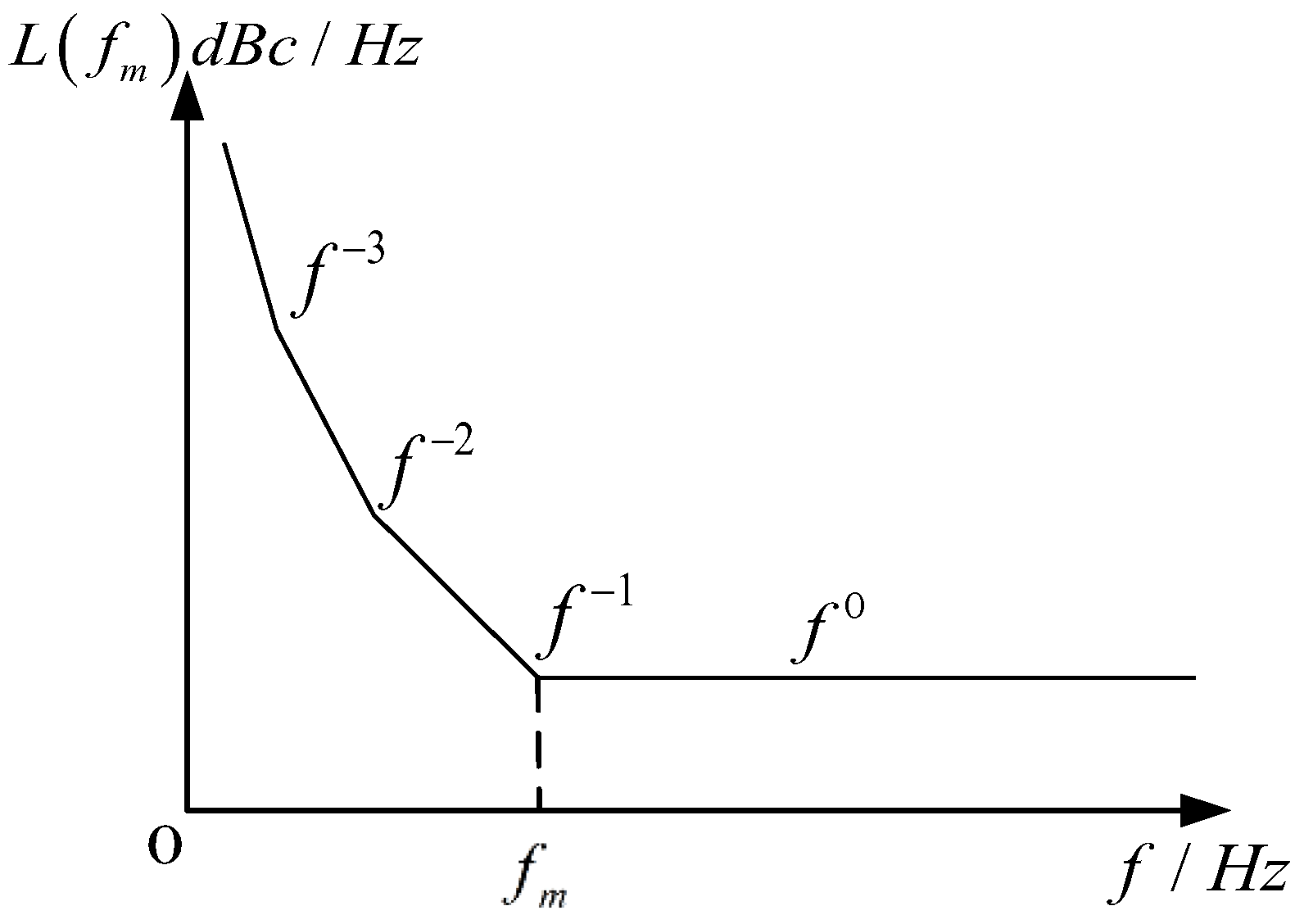


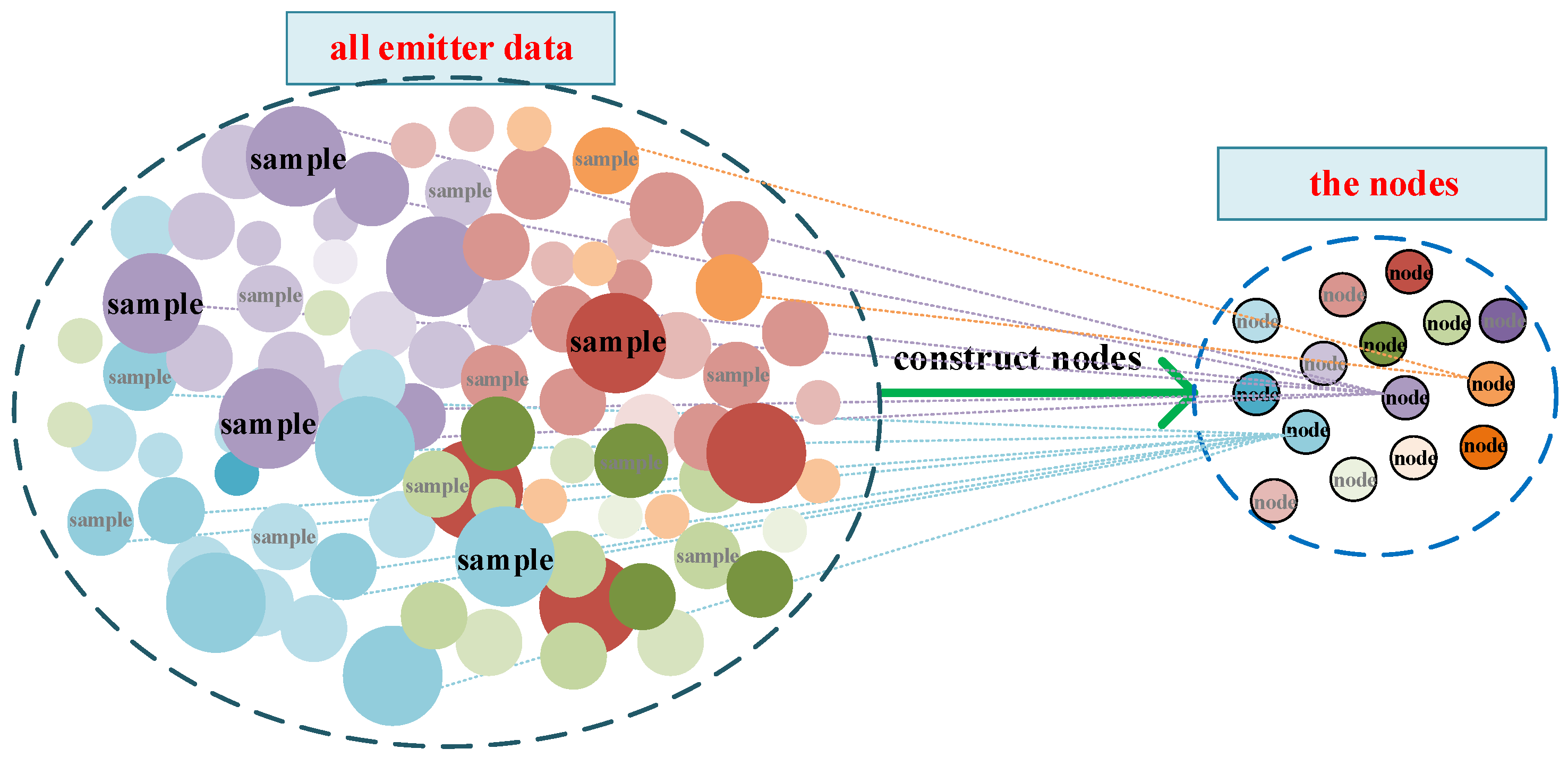

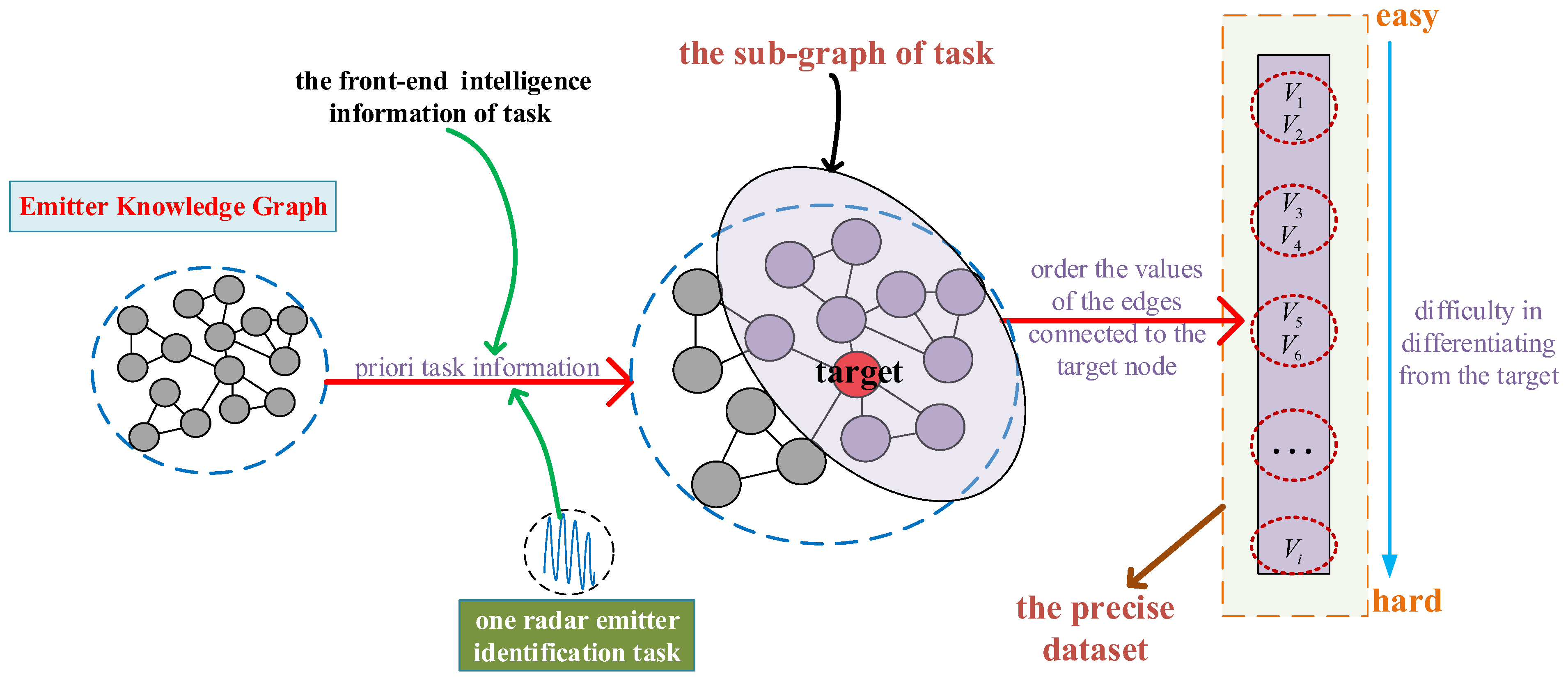

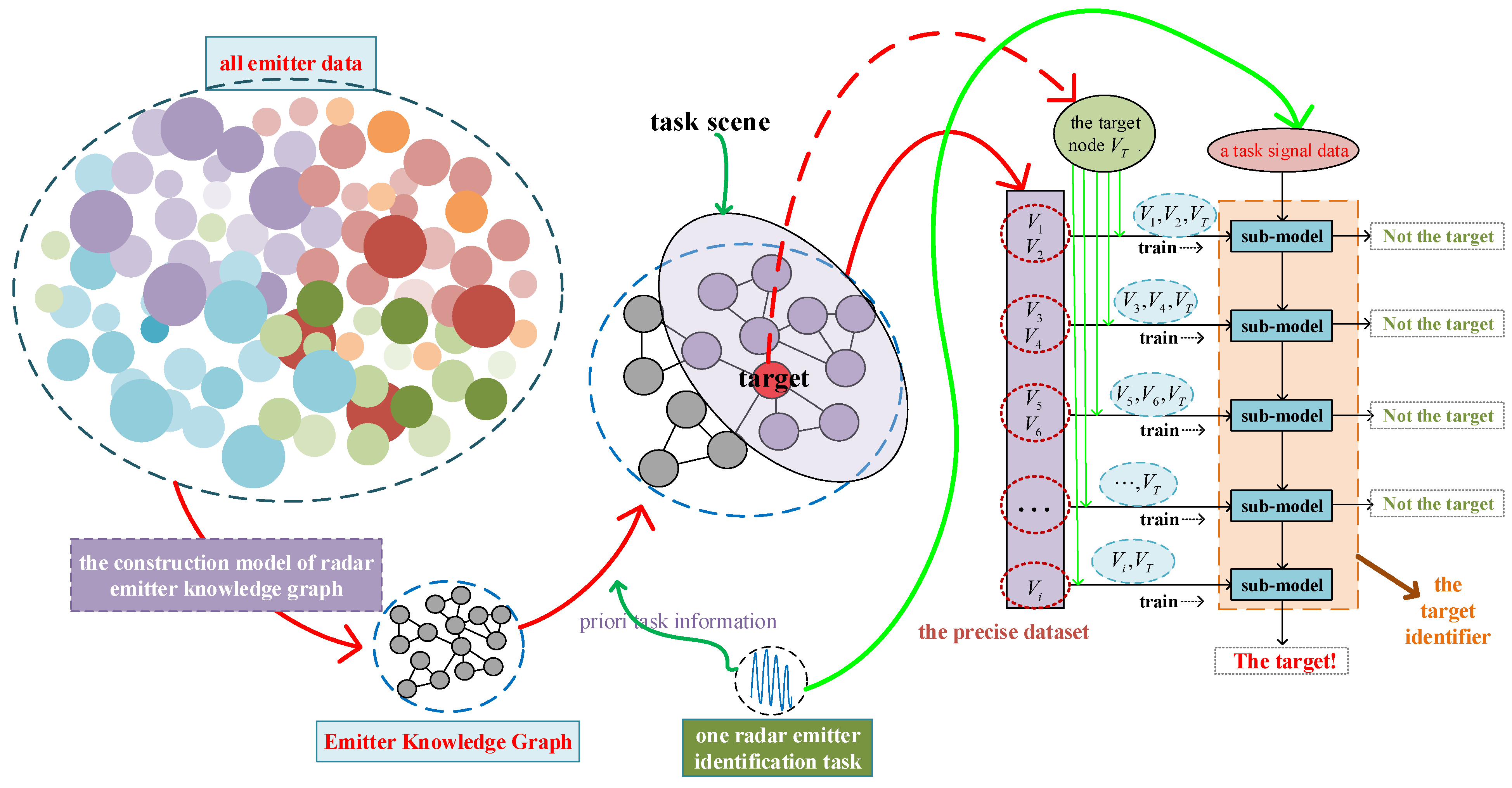

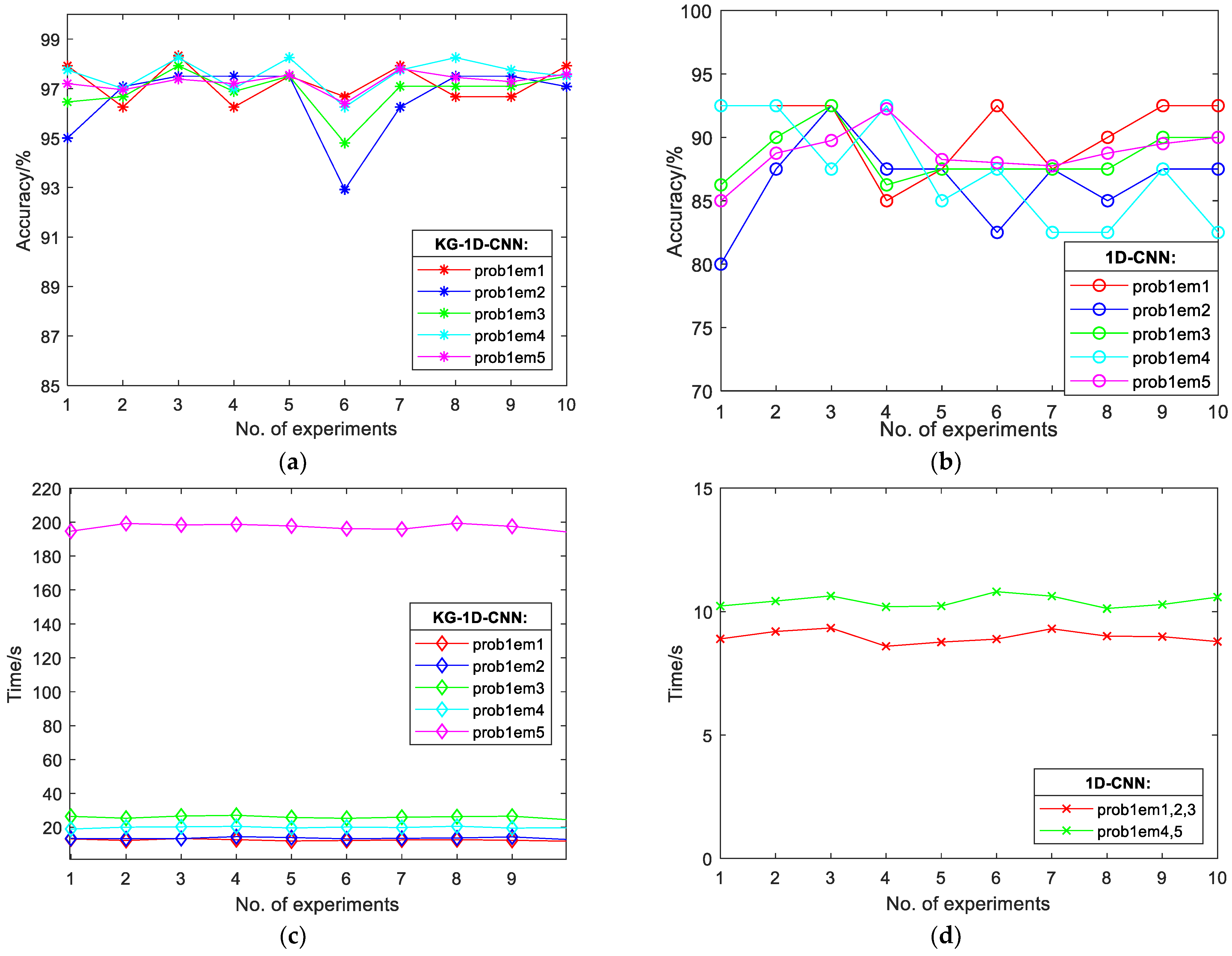
| Carrier Frequency | Frequency Bandwidth | Time Width | |
|---|---|---|---|
| Emitter 1 | 10 GHz | 30 MHz | 3 μs |
| Emitter 2 | 10 GHz | 30 MHz | 3 μs |
| Emitter 3 | 10 GHz | 30 MHz | 3 μs |
| Emitter 4 | 8 GHz | 20 MHz | 3 μs |
| Emitter 5 | 8 GHz | 20 MHz | 3 μs |
| Emitter 6 | 8 GHz | 20 MHz | 3 μs |
| Emitter 7 | 12 GHz | 40 MHz | 3 μs |
| Emitter 8 | 12 GHz | 40 MHz | 3 μs |
| Emitter 9 | 12 GHz | 40 MHz | 3 μs |
| Emitter 10 | 11 GHz | 50 MHz | 3 μs |
| Phase Noise Parameters | Filter Parameters | |||
|---|---|---|---|---|
| Frequency Offset | Phase Noise Coefficient | Sampling Frequency | Cutoff Frequency | |
| Emitter 1 | 1 kHz | 20 kHz | 200 Hz | |
| Emitter 2 | 1 kHz | 30 kHz | 150 Hz | |
| Emitter 3 | 1 kHz | 30 kHz | 200 Hz | |
| Emitter 4 | 1 kHz | 20 kHz | 200 Hz | |
| Emitter 5 | 1 kHz | 30 kHz | 150 Hz | |
| Emitter 6 | 1 kHz | 30 kHz | 200 Hz | |
| Emitter 7 | 1 kHz | 20 kHz | 200 Hz | |
| Emitter 8 | 1 kHz | 30 kHz | 150 Hz | |
| Emitter 9 | 1 kHz | 30 kHz | 200 Hz | |
| Emitter 10 | 1 kHz | 20 kHz | 100 Hz | |
| Test Problem | Target | Environment | Features |
|---|---|---|---|
| Problem 1 | Emitter 7 | (Emitter 1, Emitter 4, Emitter 6, Emitter 7, Emitter 8, Emitter9) |
|
| Problem 2 | Emitter 4 |
| |
| Problem 3 | Emitter 4, Emitter 7 |
| |
| Problem 4 | Emitter 7 | (Emitter 1—Emitter 10) |
|
| Problem 5 | Emitter 1—Emitter 10 |
|
| 1 | 2 | 3 | 4 | 5 | 6 | 7 | 8 | 9 | 10 | |
|---|---|---|---|---|---|---|---|---|---|---|
| 1 | — | 0.40 | −0.67 | 0.90 | 0.75 | 0.48 | 0.71 | 0.89 | 0.56 | 1.00 |
| 2 | 0.53 | — | −0.47 | 0.90 | 0.77 | 0.75 | 0.74 | 0.77 | 0.78 | 1.00 |
| 3 | −0.34 | −0.45 | — | 0.83 | 0.53 | 0.66 | 0.73 | 0.83 | 0.36 | 1.00 |
| 4 | 0.83 | 0.73 | 0.66 | — | 0.46 | −1.00 | 0.57 | 0.75 | 0.59 | 1.00 |
| 5 | 0.75 | 0.93 | 0.62 | 0.48 | — | −0.31 | 0.61 | 0.78 | 0.73 | 1.00 |
| 6 | 0.83 | 0.84 | 0.71 | 0.04 | −0.66 | — | 0.61 | 0.84 | 0.77 | 1.00 |
| 7 | 0.74 | 0.63 | 0.67 | 0.83 | 0.85 | 0.75 | — | 0.58 | −0.75 | 1.00 |
| 8 | 0.73 | 0.74 | 0.56 | 0.71 | 0.69 | 0.90 | 0.68 | — | −0.65 | 1.00 |
| 9 | 0.86 | 0.93 | 0.50 | 0.83 | 0.76 | 0.77 | −0.89 | −0.10 | — | 1.00 |
| 10 | 0.83 | 0.48 | 0.84 | 0.79 | 0.73 | 0.28 | 0.85 | 0.83 | 0.76 | — |
| The subgraph | 1 | 4 | 6 | 7 | 8 | 9 |
| 0.71 | 0.57 | 0.61 | — | 0.68 | −0.89 | |
| The sorting result | 1 | 8 | 6 | 4 | 9 | 7 |
| 0.71 | 0.68 | 0.61 | 0.57 | −0.89 | — |
| Experiment | Precision | Recall | F1-Score | Accuracy | Time (s) | |||
|---|---|---|---|---|---|---|---|---|
| Non-Target | Target | Non-Target | Target | Non-Target | Target | |||
| Experiment 1 | 99.50 | 90.24 | 98.06 | 97.67 | 98.75 | 93.67 | 97.92 | 13.04 |
| Experiment 2 | 98.98 | 83.72 | 96.53 | 94.74 | 97.74 | 88.89 | 96.25 | 12.15 |
| Experiment 3 | 100.00 | 90.48 | 98.02 | 100.00 | 99.00 | 95.00 | 98.33 | 13.29 |
| Experiment 4 | 98.98 | 83.72 | 96.53 | 94.74 | 97.74 | 88.89 | 96.25 | 12.60 |
| Experiment 5 | 99.51 | 86.49 | 97.58 | 96.97 | 98.54 | 91.43 | 97.50 | 11.86 |
| Experiment 6 | 100.00 | 82.22 | 96.06 | 100.00 | 97.99 | 90.24 | 96.67 | 12.12 |
| Experiment 7 | 100.00 | 86.11 | 97.61 | 100.00 | 98.79 | 92.54 | 97.92 | 12.44 |
| Experiment 8 | 99.49 | 84.44 | 96.52 | 97.44 | 97.98 | 90.48 | 96.67 | 12.61 |
| Experiment 9 | 100.00 | 81.82 | 96.08 | 100.00 | 98.00 | 90.00 | 96.67 | 12.24 |
| Experiment 10 | 100.00 | 85.71 | 97.62 | 100.00 | 98.80 | 92.31 | 97.92 | 11.72 |
| Average | 99.65 | 85.50 | 97.06 | 98.16 | 98.33 | 91.35 | 97.21 | 12.41 |
| Test Problems | 1D-CNN | KG-1D-CNN | ||
|---|---|---|---|---|
| Accuracy | Time (s) | Accuracy | Time (s) | |
| Problem 1 | 90.50 | 8.98 | 97.21 | 12.41 |
| Problem 2 | 86.50 | 8.98 | 96.58 | 13.52 |
| Problem 3 | 88.50 | 8.98 | 96.90 | 25.92 |
| Problem 4 | 87.25 | 10.41 | 97.58 | 19.87 |
| Problem 5 | 88.80 | 10.41 | 97.28 | 197.23 |
| Target Emitter | Precision | Recall | F1-Score | Accuracy | Time (s) | |||
|---|---|---|---|---|---|---|---|---|
| Non-Target | Target | Non-Target | Target | Non-Target | Target | |||
| Emitter 1 | 99.83% | 84.88% | 97.92% | 98.50% | 98.86% | 90.85% | 97.98% | 19.91 |
| Emitter 2 | 99.75% | 78.35% | 97.02% | 97.75% | 98.34% | 86.92% | 97.05% | 19.83 |
| Emitter3 | 98.70% | 77.93% | 97.21% | 88.50% | 97.90% | 82.69% | 96.25% | 19.66 |
| Emitter4 | 99.58% | 86.67% | 98.33% | 96.25% | 98.95% | 91.17% | 98.13% | 19.58 |
| Emitter5 | 99.72% | 82.89% | 97.70% | 97.50% | 98.69% | 89.47% | 97.68% | 19.70 |
| Emitter6 | 98.74% | 75.63% | 96.47% | 88.75% | 97.57% | 81.05% | 95.7% | 19.71 |
| Emitter7 | 98.89% | 86.47% | 98.42% | 90.00% | 98.65% | 88.08% | 97.58% | 19.87 |
| Emitter8 | 99.49% | 74.99% | 96.39% | 95.50% | 97.91% | 83.89% | 96.3% | 19.69 |
| Emitter9 | 98.00% | 80.04% | 96.90% | 82.00% | 97.75% | 80.90% | 96.13% | 19.63 |
| Emitter10 | 100.00% | 100.00% | 100.00% | 100.00% | 100.00% | 100.00% | 100% | 19.65 |
| Total | 99.27% | 82.79% | 97.64% | 93.48% | 98.46% | 87.50% | 97.28% | 197.23 |
| SNR | 1D-RESNET50 | CNN-Man [28] | CNN-Xiao [14] | CNN-Kevin [29] | 1D-CNN | KG-1D-CNN | ||||||
|---|---|---|---|---|---|---|---|---|---|---|---|---|
| Accuracy | Time (s) | Accuracy | Time (s) | Accuracy | Time (s) | Accuracy | Time (s) | Accuracy | Time (s) | Accuracy | Time (s) | |
| 0 dB | 50.20% | 154.91 | 56.55% | 15.8 | 52.75% | 28.40 | 53.48% | 31.60 | 51.00% | 10.67 | 91.86% | 200.42 |
| 5 dB | 70.55% | 154.17 | 74.70% | 16.02 | 73.5% | 27.91 | 74.53% | 31.62 | 71.15% | 10.24 | 95.33% | 200.65 |
| 10 dB | 92.70% | 154.67 | 93.35% | 16.04 | 93.80% | 28.23 | 93.58% | 31.38 | 88.80% | 10.41 | 97.28% | 197.23 |
| 15 dB | 97.98% | 154.49 | 99.95% | 16.13 | 98.90% | 29.77 | 99.25% | 30.20 | 97.75% | 10.13 | 99.35% | 205.44 |
| SNR | 1D-RESNET50 | CNN-Man [28] | CNN-Xiao | CNN-Kevin | 1D-CNN | KG-1D-CNN | ||||||
|---|---|---|---|---|---|---|---|---|---|---|---|---|
| Accuracy | Time (s) | Accuracy | Time (s) | Accuracy | Time (s) | Accuracy | Time (s) | Accuracy | Time (s) | Accuracy | Time (s) | |
| 0 dB | 58.33% | 294.90 | 64.13% | 26.14 | 59.00% | 49.47 | 59.28% | 56.51 | 56.73% | 16.61 | 93.30% | 310.59 |
| 5 dB | 79.00% | 295.89 | 81.75% | 26.40 | 79.43% | 49.44 | 80.84% | 57.00 | 73.55% | 16.06 | 95.47% | 320.85 |
| 10 dB | 95.25% | 295.96 | 98.55% | 26.34 | 96.28% | 49.84 | 96.40% | 56.22 | 93.48% | 16.27 | 98.62% | 314.98 |
| 15 dB | 99.25% | 296.16 | 100.00% | 26.09 | 99.94% | 51.49 | 99.37% | 57.18 | 99.33% | 16.76 | 99.70% | 310.52 |
Disclaimer/Publisher’s Note: The statements, opinions and data contained in all publications are solely those of the individual author(s) and contributor(s) and not of MDPI and/or the editor(s). MDPI and/or the editor(s) disclaim responsibility for any injury to people or property resulting from any ideas, methods, instructions or products referred to in the content. |
© 2023 by the authors. Licensee MDPI, Basel, Switzerland. This article is an open access article distributed under the terms and conditions of the Creative Commons Attribution (CC BY) license (https://creativecommons.org/licenses/by/4.0/).
Share and Cite
Chen, Y.; Li, P.; Yan, E.; Jing, Z.; Liu, G.; Wang, Z. A Knowledge Graph-Driven CNN for Radar Emitter Identification. Remote Sens. 2023, 15, 3289. https://doi.org/10.3390/rs15133289
Chen Y, Li P, Yan E, Jing Z, Liu G, Wang Z. A Knowledge Graph-Driven CNN for Radar Emitter Identification. Remote Sensing. 2023; 15(13):3289. https://doi.org/10.3390/rs15133289
Chicago/Turabian StyleChen, Yingchao, Peng Li, Erxing Yan, Zehuan Jing, Gaogao Liu, and Zhao Wang. 2023. "A Knowledge Graph-Driven CNN for Radar Emitter Identification" Remote Sensing 15, no. 13: 3289. https://doi.org/10.3390/rs15133289
APA StyleChen, Y., Li, P., Yan, E., Jing, Z., Liu, G., & Wang, Z. (2023). A Knowledge Graph-Driven CNN for Radar Emitter Identification. Remote Sensing, 15(13), 3289. https://doi.org/10.3390/rs15133289






